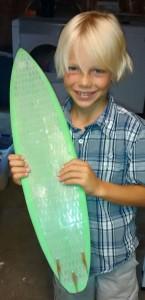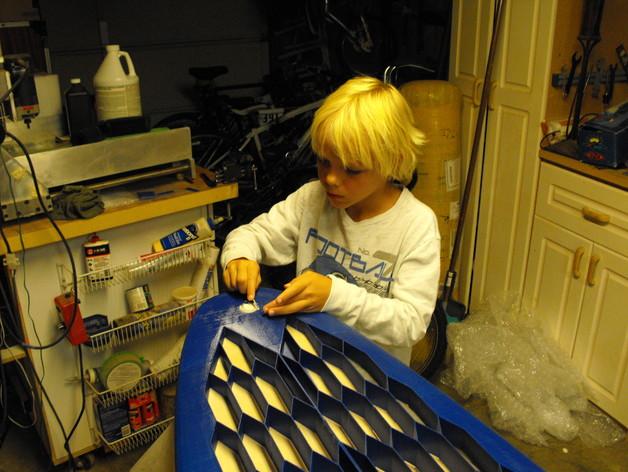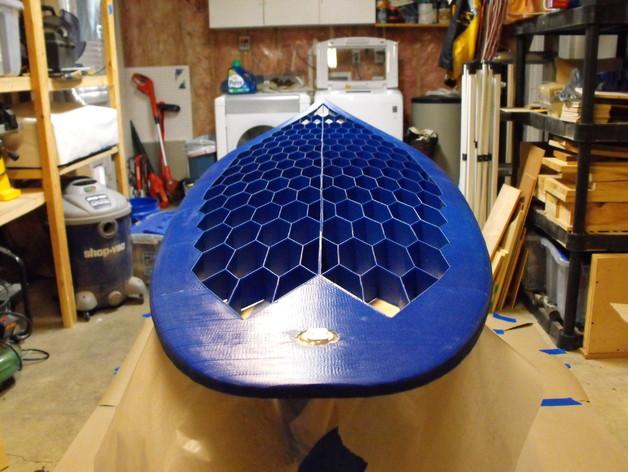
Matej poses with 1/3 scale test print
It’s hard to find anything these days that somebody hasn’t already created using a 3D printer or at least made a decent go at it. In July we covered an Australian company that is producing 3D printed surfboards… as models for full sized creation on a CNC. Now, we bring you what may very well be the first completely 3D printed, full size surfboard.
As many of these kinds of projects do, it began with a conversation between father and son over breakfast. As they ate, the pair had been admiring miniature surfboards that adorned the walls of the restaurant.
Jody Roth, the father in this case, recalls on his blog “Hobbies of a Bogue Rat” that he said to his son, “I bet we could make a surfboard on the 3D printer…”
To this, his son immediately and enthusiastically replied, “That would be so cool!”
And from these humble beginnings was born a yearlong process of design, refinement, and innovation. In the end, Roth characterizes the board that they created as being ‘mediocre,’ but when doing something that has never been done before, rising to the level of even mediocre is a pretty stellar accomplishment. Roth’s final files are available on Thingiverse.

Model in BoardCAD
They began by looking at the default template in BoardCAD in order to define the initial shape. BoardCAD is an open source CAD/CAM program devoted entirely to the art of surfboard creation and allows users to edit and create their own boards for export to an STL file. Having access to this software made it possible to advance to the next stage: importing the design into Solidworks using the extruded cut pattern. Roth experimented with several variations in the size and spacing and eventually settled on using a 35 mm base that would lighten the piece somewhat while still allowing it to support the glass.
Once he had made the final adjustments to allow for responses to the unique nature of his board’s mode of production, he used netfabb Studio Basic to slice the 3D model into pieces that were manageable for his printer. In the end, he had nine lengthwise pieces and seven cut along the stringer. Each section of the board was saved as an individual STL file.

1/3 scale model print
Then came the first moment of truth: the test print. The model was printed at 1/3 scale and is pretty cool and it and of itself. Roth noted that at one point the print head shifted on the y-axis putting the rest of the layers off by about a millimeter, reinforcing his idea that the bigger board should be printed in sections so that it would minimize loss should something of that nature occur again. After discarding the trim, the entire model was assembled with fast set acrylic glue and they even put on a glass coat just to get the feel of it.
Now that they had cut their teeth on the 1/3 scale version, the pair were ready to confront the prospect of printing at full scale. Each part took a total of 10 hours to print with only one major mechanical meltdown (in the middle of the night, as is usual with those sorts of things). Roth described the experience:
“I had tried to get some extra z-axis height by raising the extruder up off the rods by an inch which made it less stable at high speed. Unfortunately, it happened that a roll of filament became tangled and the resulting mess occurred in the middle of the night. So, whilst I slept, my 3D printer was noisily destroying itself. In the morning, I was unpleasantly surprised to find a broken belt mount and a pile of spaghetti on the floor. I took this opportunity to fix all the quirks of my printer and stabilize the extruder.”
Roth admits that the process of assembly was tedious and had him daydreaming of building a 3 foot tall by 2 foot wide printer so that he could create the board in one go next time.
Once the board was fully assembled, he began to apply the glassing. The first problem he encountered was some splitting in the board under its own weight and so he responded by building a support system to hold it in shape until it was glassed. It was at that point that he decided his son, Matej, could contribute some elbow grease to the project and so he was called in to help with the vented leash cup.
 When all was said and done, Roth noted that the overall cost of producing this board at home was probably not significantly less than it would have cost to buy a traditional board in a store and the time investment was quite significant. However, the feeling I get from reading his blog is this:
When all was said and done, Roth noted that the overall cost of producing this board at home was probably not significantly less than it would have cost to buy a traditional board in a store and the time investment was quite significant. However, the feeling I get from reading his blog is this:
Filament and Time: 1,028,117 mm & 164 days
Becoming Coolest Dad Ever in Eyes of Son: Priceless.
Would you have the patience to create such a large scale 3D print? Discuss this story in the 3D Printed Surfboard forum thread on 3DPB.com
Subscribe to Our Email Newsletter
Stay up-to-date on all the latest news from the 3D printing industry and receive information and offers from third party vendors.
You May Also Like
Precision at the Microscale: UK Researchers Advance Medical Devices with BMF’s 3D Printing Tech
University of Nottingham researchers are using Boston Micro Fabrication‘s (BMF) 3D printing technology to develop medical devices that improve compatibility with human tissue. Funded by a UK grant, this project...
3D Printing Webinar and Event Roundup: April 21, 2024
It’s another busy week of webinars and events, starting with Hannover Messe in Germany and continuing with Metalcasting Congress, Chinaplas, TechBlick’s Innovation Festival, and more. Stratasys continues its advanced training...
3D Printing Webinar and Event Roundup: March 17, 2024
It’s another busy week of webinars and events, including SALMED 2024 and AM Forum in Berlin. Stratasys continues its in-person training and is offering two webinars, ASTM is holding a...
3D Printed Micro Antenna is 15% Smaller and 6X Lighter
Horizon Microtechnologies has achieved success in creating a high-frequency D-Band horn antenna through micro 3D printing. However, this achievement did not rely solely on 3D printing; it involved a combination...






























